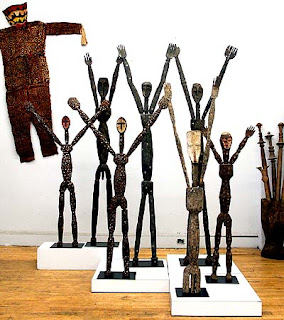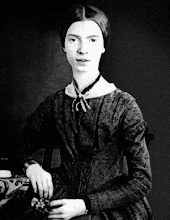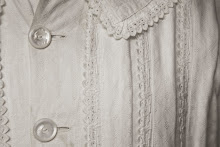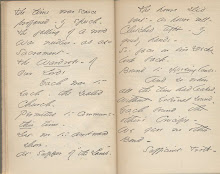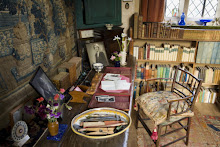 |
| Where and when it all started: |
The above piece I've called the Three Graces. This was done is reaction to a post that Jude Hill did on her blog after the hurricane that passed this past Summer. The one that did considerable damage along the Eastern Coast of the US. I remember Jude picking up an oak leaf and holding it, mentioning that a lot of the leaves were blown off the trees (last week in August - not tree mottling season by any means) and that they had lost one of the old oak trees that was on their property. There was a feeling of sadness that translated into beauty. Holding many moments without deciding, September 3, 2011

The image above is what I remember most of those days from her blog. The cloth on the right became the Hurricane Cloth.
I started looking and thinking about leaves very differently after that. Watching especially those transitional ones - the ones that change color, fall, get walked/trampled on. Go from whole to fragments, dust and a final return.
While collecting these leaves, I also posted a few blog entries, here, regarding Emily Dickinson. I remember going to her home, entering and peaking to see if it was permitted to walk through a door that presented a cold, dark exhibition area. It had formerly been a place where Emily use to sit and watch over her garden, changing through the seasons. She would hid out here, especially in the winter when, though not much warmer in this room, it was too cold to venture out. On display there, there were a few folios that held open pages of her herbarium. (Herbaria are know to go back to the 1600. They were those volumes upon volumes where people would press and hold flora. Memory devices, I like to think, more then how we think of them today - botanic study tools.) How different were these from her fascicles? - those composed, stitched, hidden little one installment pamphlets that became her first "printed" edition of the poems. They were small in size, spare in text, but left riches for all time. A small view into her private moments. They were her secret keepers - her memory devices. I like to think that her herbaria were not that different of a gesture.
 |
| Image of a fascicle page by Emily Dickinson |
For on-line views of some of the Dickinson archives go to: Harvard Archive.
The library works closely with the Emily Dickinson Museum and the Emily Dickinson International Society to bring its collections to the public. Descriptive information about the family library and about Dickinson's manuscript books or fascicles, letters, herbarium, and family photographs are now on the Web, with a growing number of linked digital facsimiles.
Page from Emily Dickinson - Herbarium. (left) Cover, volume 1, Emily Dickinson - Herbarium (right)
Several other objects of inspiration also came along to add to my thought processing. One of Lynne Hoppe's blog: muslin pages tutorial, Lynne Hoppe actually got me thinking back to my days of book binding. I spent a lot of my undergraduate years assembling what might be referred to as "artist's books." A big part of my work was alternative photo-processed images that were then gather as books. Lynne's muslin book brought back memories of those youthful, energetic, and spirited school days:
I really got inspired to start thinking about actually doing cloth books with my stitching from this image. So somewhere between the top image and Lynne's book this is what I ended up with as an initial step:
The image above is a translation of the first image on top of this blog page done in all cloth. The are just pinned at this point. The leaves are cloth that has been rusted and two leaves, one oak and one maple were use to trace the shape and then cut out. This is pinned to a piece of muslin cloth. I then drew the face. This piece in turn was pinned to a cloth that has been dyed in walnut, rust and indigo carmine. Each piece in itself is about 8.5x10" - they are separate at the moment.
These were the other additional things that came along which really contributed more fuel to my thoughts. Robyn, Art Propelled did an entry on The Poetry of Leaves, December 7th. I kept going back and looking at the images - they just really wouldn't go away. Wouldn't leave my thoughts. Two of the artists she mentioned especially were intriguing to the mental composing that was going on during those nights that I couldn't sleep, and kept drawing in my mind. Patrick Boehner and Ronald Chase.
The two top images are from Patrick Boehner.
Left: Title: Found Objects (Beginning and End)
Artist: Patrick Boehner
Date: 2008
Height: 9 ½" | Width: 8" | Edition of 50, 1 AP
Height: 7.7" | Width: 6.4" | Open Edition
Right: Title: Documentation and Interpretation (Imperfect Remains)
Artist: Patrick Boehner
Date: 2010
Height: 16 ½" | Width: 11 ½" | Edition of 25, 1 AP
The lower left is a 1994 book titled LEAF by Ronald Chase. There isn't too much information that I could find about the size or edition. But, I liked the "aged" look of the paper and the fragile quality. It really reminded me of something Emily Dickinson might have picked up, held and looked at.
The other two images come from the Field Museum of Natural History in Chicago, on-line data base. I've put at the bottom of the blog page, beneath the comment box, three links to on-line databases, with images, for those that might want to do some further image collecting. In addition to the Field, there are Harvard University, the largest Herbarium in the US and the University of Michigan's on-line data base. They titled their's Herbarium but in fact it is a archive of flora in Michigan. Nice thing about their database, no Latin required.
I should add also that I worked at the Field Museum of Natural History as a curatorial assistant for 3 years while I was an undergraduate...many a lunch break was spent investigating those dark, musty botany galleries.
Finally another artist that I discovered making botanical prints is Katie Cooke. Her photographic method is wet plat collodion - probably one of the oldest forms of making an image mechanically. It requires a glass plate upon which a "gel" like medium is placed in which are suspended the crystals that will capture the image. A tricky process but such an incredible end product.
So this brings me, now, to what I'm doing with all this information.
This is my journal page with the ideas outlined for this blog's text.
I started collecting leaves shortly after Jude's Hurricane Cloth inspiration. Each leaf was unique and fascinating treasure. I think I have them all over my house and in books. I just hope I'm going to remember where I've tucked them all in. One day I will open those pages and find crumbles of leaves falling out - I'll remember (hopefully) and smile. The top left is a mock-up of a "fascicle." I'm planning on stitching up little books of the leaves as they go through the seasons during next year. They will be traced, stitched/embellished and "bound" into little fascicle like studies. I want to use naturally dyed cloth for the actual "leaf" images but the base cloth will be unbleached muslin. (this will be sort of a on-going project in addition to the work I'll be doing over with Jude at Diaries, 2012. Sometime, I'm finding, small in hand "sketching" "skatching" "skitching" and cloth- journalling - defined as in daily/routine - is a nice break to practice ideas, stitches, general thinking, that might fuel a little of the other work.)
Below cloth for leaf "fascicle" project:
 |
| Top rust, middle oak leaf cooked and soaked for three weeks, bottom tea. |
Two stitched up leaves that I have completed are: (these are practice pieces)
 |
| Oak leaf appliqued, dyed: rust; base cloth, dyed: indigo carmine |
 |
| Oak leaf traced and stitched on dyed cloth, acorn; commercially produced cloth |
I started these as a small distraction, relief, to stitching the cloth that I'm working on for Magic Diaries, LEFT. LEFT, is just about done. Hopefully next week I'll be showing the cloth as a finished product. Lots of little stitches and a few rough days with mom's health have not made the work just a slow cloth but a slower cloth.
 |
| The above book is made by Aimee Lee. Her blog is: It's My Party, this was featured on Wake Robin's blog. |
I would also be remiss if I didn't give a nod to velma. Her books just take my breath away. Images like those above and below can be found through out Velma's blog.
References:
Finally my favorite bibliophile's quote on the leaf. It's from John Carter's ABC for Book Collectors. New Castle, DE: Oak Knoll Press and The British Library; 8th edition (June 1, 2004) This is absolutely one of the treasure from my days as a Library Science student. Not all our text books could make one laugh!
Leaf: The basic bibliographical unite: the piece of paper comprising one page on its front side (recto, obverse) and another on its back (verso, reverse). Leaf, leaves are abbreviated to l., ll., or f., ff. (from folio). The inaccurate and slovenly misuse of page for leaf (e.g. 'the verso of p. 73,' 'the title-page is a cancel') appears to be on the increase and should be pilloried when found. Maybe only librarians, bibliophiles, and binders will find this amusing...but please, if you find such errors, do pillorize for the old boy!
And if you leave here with nothing else then a new word - word for the day kind of thing: dendrology, the study of trees. Dendriod is also nice - resembling a tree. Now I need to find the word for study of leaves. I'm sure there must be one...if not, I'll just have to....
Postscript to anyone who might be viewing this blog...if I have used your images incorrectly, my apologies. I haven't been blogging that long so some of the etiquette of the internet is still part of my learning curve. Hopefully I will be wiser in the future. Thank you.



































